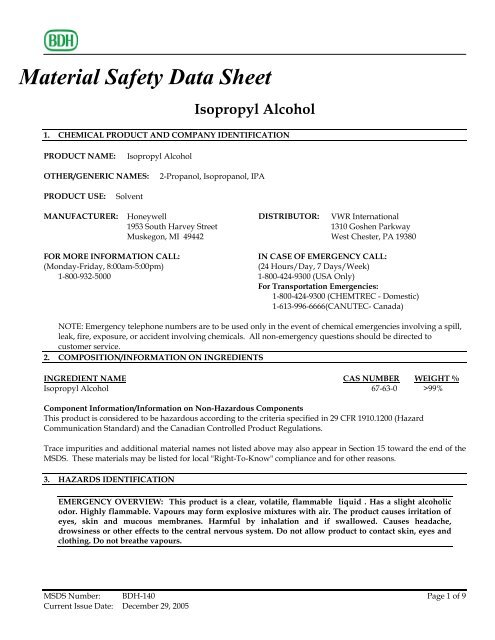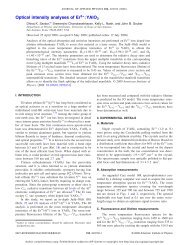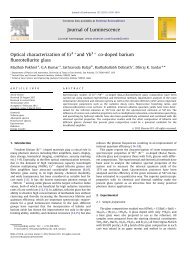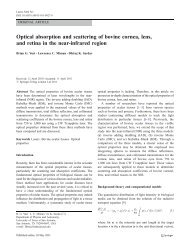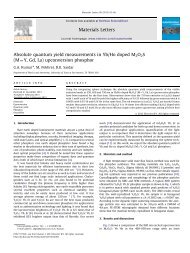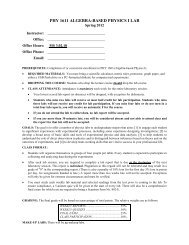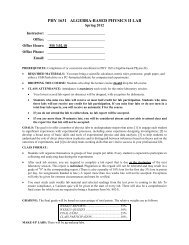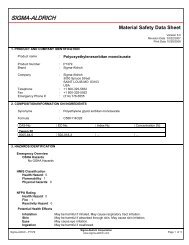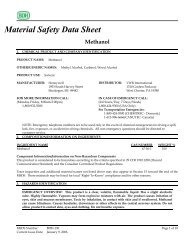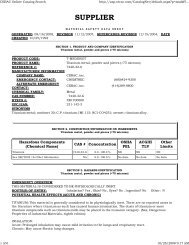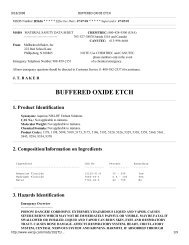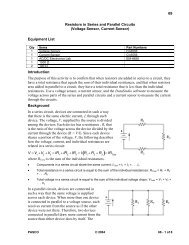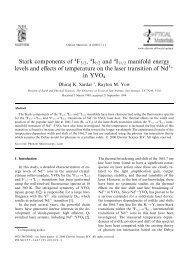Create successful ePaper yourself
Turn your PDF publications into a flip-book with our unique Google optimized e-Paper software.
Material Safety Data Sheet<br />
Isopropyl Alcohol<br />
1. CHEMICAL PRODUCT AND COMPANY IDENTIFICATION<br />
PRODUCT NAME: Isopropyl Alcohol<br />
OTHER/GENERIC NAMES: 2-<strong>Propanol</strong>, Isopropanol, IPA<br />
PRODUCT USE: Solvent<br />
MANUFACTURER: Honeywell<br />
1953 South Harvey Street<br />
Muskegon, MI 49442<br />
DISTRIBUTOR: VWR International<br />
1310 Goshen Parkway<br />
West Chester, PA 19380<br />
FOR MORE INFORMATION CALL: IN CASE OF EMERGENCY CALL:<br />
(Monday-Friday, 8:00am-5:00pm)<br />
1-800-932-5000<br />
(24 Hours/Day, 7 Days/Week)<br />
1-800-424-9300 (USA Only)<br />
For Transportation Emergencies:<br />
1-800-424-9300 (CHEMTREC - Domestic)<br />
1-613-996-6666(CANUTEC- Canada)<br />
NOTE: Emergency telephone numbers are to be used only in the event of chemical emergencies involving a spill,<br />
leak, fire, exposure, or accident involving chemicals. All non-emergency questions should be directed to<br />
customer service.<br />
2. COMPOSITION/INFORMATION ON INGREDIENTS<br />
INGREDIENT NAME CAS NUMBER WEIGHT %<br />
Isopropyl Alcohol 67-63-0 >99%<br />
Component Information/Information on Non-Hazardous Components<br />
This product is considered to be hazardous according to the criteria specified in 29 CFR 1910.1200 (Hazard<br />
Communication Standard) and the Canadian Controlled Product Regulations.<br />
Trace impurities and additional material names not listed above may also appear in Section 15 toward the end of the<br />
MSDS. These materials may be listed for local "Right-To-Know" compliance and for other reasons.<br />
3. HAZARDS IDENTIFICATION<br />
EMERGENCY OVERVIEW: This product is a clear, volatile, flammable liquid . Has a slight alcoholic<br />
odor. Highly flammable. Vapours may form explosive mixtures with air. The product causes irritation of<br />
eyes, skin and mucous membranes. Harmful by inhalation and if swallowed. Causes headache,<br />
drowsiness or other effects to the central nervous system. Do not allow product to contact skin, eyes and<br />
clothing. Do not breathe vapours.<br />
MSDS Number: BDH-140 Page 1 of 9<br />
Current Issue Date: December 29, 2005
POTENTIAL HEALTH HAZARDS<br />
MATERIAL SAFETY DATA SHEET<br />
Isopropyl Alcohol<br />
SKIN: Irritating to skin. Skin absorption may cause toxic effects similar to those described for inhalation.<br />
Repeated or extended contact may cause erythema (reddening of the skin) or dermatitis, resulting from<br />
a defatting action on tissue.<br />
EYES: Irritating to eyes. Symptoms include itching, burning, redness and tearing. Prolonged contact may<br />
cause eye damage .<br />
INHALATION: Vapours may cause drowsiness and dizziness. Inhalation of high vapour concentrations can<br />
cause CNS-depression and narcosis. Severe overexposure may produce more serious<br />
symptoms, including coma and risk of kidney damage.<br />
INGESTION: Ingestion of this product may result in central nervous system effects including headache,<br />
sleepiness, dizziness, slurred speech and blurred vision.<br />
DELAYED EFFECTS: Repeated or prolonged exposure may cause damage to the bladder, liver and kidney .<br />
MEDICAL CONDITIONS<br />
AGGRAVATED BY EXPOSURE:<br />
Pre-existing liver or kidney dysfunctions, or central nervous system<br />
disorders may be aggravated by exposure.<br />
HMIS Ratings: Health: 2 Fire: 3 Physical Hazard: 0<br />
Hazard Scale: 0 = Minimal 1 = Slight 2 = Moderate 3 = Serious 4 = Severe * = Chronic hazard<br />
Ingredients found on one of the OSHA designated carcinogen lists are listed below.<br />
INGREDIENT NAME NTP STATUS IARC STATUS OSHA LIST<br />
No component of this product at levels greater than or equal to 0.1% is identified as a carcinogen by ACGIH, IARC,<br />
NTP or OSHA.<br />
4. FIRST AID MEASURES<br />
SKIN: Wash off immediately with soap and plenty of water. Take off contaminated clothing and shoes<br />
immediately. Wash contaminated clothing before re-use. Obtain medical attention.<br />
EYES: Rinse immediately with plenty of water, also under the eyelids, for at least 15 minutes. Obtain medical<br />
attention.<br />
INHALATION: Move to fresh air in case of accidental inhalation of vapours. If not breathing, give artificial<br />
respiration. If breathing is difficult, give oxygen, provided a qualified operator is available. Call<br />
a physician immediately.<br />
INGESTION: DO NOT induce vomiting. Immediate medical attention is required.<br />
ADVICE TO PHYSICIAN: Treat symptomatically.<br />
MSDS Number: BDH-140 Page 2 of 9<br />
Current Issue Date: December 29, 2005
5. FIRE FIGHTING MEASURES<br />
FLAMMABLE PROPERTIES<br />
MATERIAL SAFETY DATA SHEET<br />
Isopropyl Alcohol<br />
FLASH POINT: 53.6°F (12°C)<br />
FLASH POINT METHOD: Closed Cup<br />
AUTOIGNITION TEMPERATURE: 750°F (399°C)<br />
UPPER FLAME LIMIT (volume % in air): 12.0<br />
LOWER FLAME LIMIT (volume % in air): 2.0<br />
FLAME PROPAGATION RATE (solids): Not applicable<br />
OSHA FLAMMABILITY CLASS: Class 1B Flammable Liquid<br />
EXTINGUISHING MEDIA:<br />
Use alcohol-resistant foam , carbon dioxide (CO2) or dry chemical.<br />
UNUSUAL FIRE AND EXPLOSION HAZARDS:<br />
Highly flammable. Vapours may form explosive mixtures with air. Vapours are heavier than air and may travel<br />
along the ground to some distant source of ignition and flash back.<br />
Hazardous combustion products may include carbon monoxide, carbon dioxide (CO2).<br />
SPECIAL FIRE FIGHTING PRECAUTIONS/INSTRUCTIONS:<br />
Water may be ineffective. Fire or intense heat may cause violent rupture of packages. Fire-fighters should wear<br />
self-contained, NIOSH-approved breathing apparatus and full protective clothing. Fire or intense heat may cause<br />
violent rupture of packages. In the event of fire, cool tanks with water spray. Do not use a solid water stream as it<br />
may scatter and spread fire. After fire, flush area with water to prevent re-ignition. Do not allow run-off from fire<br />
fighting to enter drains or water courses.<br />
NFPA Ratings: Health: 2 Fire: 3 Reactivity: 0<br />
Hazard Scale: 0 = Minimal 1 = Slight 2 = Moderate 3 = Serious 4 = Severe<br />
6. ACCIDENTAL RELEASE MEASURES<br />
IN CASE OF SPILL OR OTHER RELEASE:<br />
Containment Procedures: Use personal protective equipment. Ensure adequate ventilation. Remove all sources of<br />
ignition. Stop flow of material, if this is without risk.<br />
Cleanup Procedures: Soak up with inert absorbent material (e.g. sand, silica gel, acid binder, universal binder,<br />
sawdust). Shovel into suitable container for disposal. Do not use sparking tools. Do not allow product to enter<br />
sewer or waterways.<br />
Evacuation Procedures: Keep unnecessary people away. Isolate area.<br />
Special Procedures: Use personal protective equipment. Remove all sources of ignition.<br />
Spills and releases may have to be reported to Federal and/or local authorities. See Section 15 regarding reporting<br />
requirements.<br />
MSDS Number: BDH-140 Page 3 of 9<br />
Current Issue Date: December 29, 2005
7. HANDLING AND STORAGE<br />
MATERIAL SAFETY DATA SHEET<br />
Isopropyl Alcohol<br />
NORMAL HANDLING: (Always wear recommended personal protective equipment.)<br />
Ensure all equipment is electrically grounded before beginning transfer operations. Ensure adequate ventilation.<br />
Avoid contact with skin, eyes and clothing. Do not breathe vapours. Keep away from fire, sparks and heated<br />
surfaces. Keep container tightly closed in a dry and well-ventilated place. Not for human consumption.<br />
STORAGE RECOMMENDATIONS:<br />
Keep in a well-ventilated place. Empty containers may retain product residue including Flammable or Explosive<br />
vapours. Do not cut, drill, grind, or weld near full, partially full, or empty product containers. Keep away from<br />
heat and sources of ignition. Store away from incompatible substances. Re-open used containers with caution.<br />
Containers which are opened must be carefully resealed and kept upright to prevent leakage. Store in area<br />
designed for storage of flammable liquids. Protect from physical damage .<br />
8. EXPOSURE CONTROLS/PERSONAL PROTECTION<br />
ENGINEERING CONTROLS:<br />
Provide local and general exhaust ventilation to effectively remove and prevent buildup of any vapours or mists<br />
generated from the handling of this product or use product in closed system. Local exhaust ventilation is<br />
preferred. Prevent electrostatic charge build-up by using common bonding and grounding techniques.<br />
PERSONAL PROTECTIVE EQUIPMENT<br />
SKIN PROTECTION:<br />
Wear impervious gloves and flame retardant antistatic protective clothing. Gloves must be inspected prior to<br />
use. For leak, spills, or other emergency, use full protective equipment.<br />
EYE PROTECTION:<br />
For handling in closed ventilation system, wear safety glasses with side-shields. For leak, spill or other<br />
emergency, use chemical goggles and face-shield. Remove contact lenses.<br />
RESPIRATORY PROTECTION:<br />
When workers are facing concentrations above the exposure limit they must use appropriate certified<br />
respirators.<br />
ADDITIONAL RECOMMENDATIONS:<br />
Provide eyewash stations and quick-drench shower facilities. High standards of skin care and personal<br />
hygiene should be exercised at all times.<br />
MSDS Number: BDH-140 Page 4 of 9<br />
Current Issue Date: December 29, 2005
EXPOSURE GUIDELINES<br />
MATERIAL SAFETY DATA SHEET<br />
Isopropyl Alcohol<br />
Component Exposure Limits<br />
Isopropyl alcohol (67-63-0)<br />
ACGIH: 200 ppm TWA<br />
400 ppm STEL<br />
OSHA (Final): 400 ppm TWA; 980 mg/m3 TWA<br />
OSHA (Vacated): 400 ppm TWA; 980 mg/m3 TWA<br />
500 ppm STEL; 1225 mg/m3 STEL<br />
NIOSH: 400 ppm TWA; 980 mg/m3 TWA<br />
500 ppm STEL; 1225 mg/m3 STEL<br />
Alberta: 400 ppm TWA; 983 mg/m3 TWA<br />
500 ppm STEL; 1230 mg/m3 STEL<br />
British Columbia: 200 ppm TWA<br />
400 ppm STEL<br />
Manitoba: 400 ppm TWA; 980 mg/m3 TWA<br />
500 ppm STEL; 1225 mg/m3 STEL<br />
New Brunswick: 400 ppm TWA; 983 mg/m3 TWA<br />
500 ppm STEL; 1230 mg/m3 STEL<br />
Northwest Territories: 400 ppm TWA; 983 mg/m3 TWA<br />
500 ppm STEL; 1228 mg/m3 STEL<br />
Skin notation<br />
Nova Scotia: 200 ppm TWA<br />
400 ppm STEL<br />
Nunavut: 400 ppm TWA; 983 mg/m3 TWA<br />
500 ppm STEL; 1228 mg/m3 STEL<br />
Skin notation<br />
Ontario: 200 ppm TWAEV<br />
400 ppm STEV<br />
Quebec: 400 ppm TWAEV; 985 mg/m3 TWAEV<br />
500 ppm STEV; 1230 mg/m3 STEV<br />
Saskatchewan: 983 mg/m3 TWA; 400 ppm TWA<br />
1230 mg/m3 STEL; 500 ppm STEL<br />
Yukon: 400 ppm TWA; 980 mg/m3 TWA<br />
500 ppm STEL; 1225 mg/m3 STEL<br />
Skin notation<br />
9. PHYSICAL AND CHEMICAL PROPERTIES<br />
APPEARANCE: Clear, colorless liquid<br />
PHYSICAL STATE: Liquid<br />
MOLECULAR WEIGHT: 60.11<br />
CHEMICAL FORMULA: (CH3)2CHOH<br />
ODOR: Slight alcohol<br />
SPECIFIC GRAVITY (water = 1.0): 0.785 at 77°F (25°C)<br />
SOLUBILITY IN WATER (weight %): Complete<br />
MSDS Number: BDH-140 Page 5 of 9<br />
Current Issue Date: December 29, 2005
MATERIAL SAFETY DATA SHEET<br />
Isopropyl Alcohol<br />
pH: Not applicable<br />
BOILING POINT: 180.1°F (82.3°C)<br />
MELTING POINT: -126.4°F (-88°C)<br />
VAPOUR PRESSURE: 33 mm Hg<br />
VAPOUR DENSITY (air = 1.0): 2.1<br />
EVAPORATION RATE: ~3 COMPARED TO: Butyl Acetate = 1<br />
% VOLATILES: 100<br />
FLASH POINT: 53.6°F (12°C)<br />
(Flash point method and additional flammability data are found in Section 5.)<br />
10. STABILITY AND REACTIVITY<br />
NORMALLY STABLE? (CONDITIONS TO AVOID):<br />
Stable under recommended storage conditions.<br />
Avoid: Heat, flames and sparks. Incompatible products Keep away from direct sunlight.<br />
INCOMPATIBILITIES:<br />
Avoid strong oxidizers, strong acids, and reactive metals including aluminium. Forms ketones in the presence of<br />
oxygen.<br />
HAZARDOUS DECOMPOSITION PRODUCTS:<br />
Hazardous decomposition products include carbon monoxide and carbon dioxide (CO2).<br />
HAZARDOUS POLYMERISATION:<br />
Hazardous polymerisation does not occur.<br />
11. TOXICOLOGICAL INFORMATION<br />
Component Analysis - LD50/LC50<br />
Isopropyl alcohol (67-63-0)<br />
Rat: LD50 – Route: Inhalation; Dose: 72.6 mg/L/4H<br />
LD50 – Route: Oral; Dose: 4396 mg/kg<br />
Rabbit: LD50 – Route: Dermal; Dose: 12800 mg/kg<br />
IMMEDIATE (ACUTE) EFFECTS:<br />
The product causes irritation of eyes, skin and mucous membranes. Harmful by inhalation and if swallowed.<br />
Causes headache, drowsiness or other effects to the central nervous system.<br />
DELAYED (SUBCHRONIC AND CHRONIC) EFFECTS:<br />
Repeated or prolonged exposure may cause damage to the bladder, liver and kidney .<br />
Subchronic Inhalation (rat): TCLo 5000 ppm/6 hr/day for 90 days (intermittent) caused a change in motor<br />
activity.<br />
Chronic Inhalation (rat): TCLo 2500 ppm/6 hr/day for 2 years (intermittent) caused changes in liver and bladder<br />
weight and changes in urine composition.<br />
MSDS Number: BDH-140 Page 6 of 9<br />
Current Issue Date: December 29, 2005
MATERIAL SAFETY DATA SHEET<br />
Isopropyl Alcohol<br />
OTHER DATA:<br />
This material is not known or reported to be carcinogenic by any reference source including IARC, OSHA, NTP,<br />
or EPA.<br />
12. ECOLOGICAL INFORMATION<br />
Prevent from entering sewer or waterway. This material is not expected to be harmful to aquatic life.<br />
Component Analysis - Ecotoxicity - Aquatic Toxicity<br />
Isopropyl alcohol (67-63-0)<br />
Test & Species Conditions<br />
96 Hr LC50 fathead minnow (29 days old) 94900 mg/L flow-through<br />
96 Hr LC50 fathead minnow (31 days old) 61200 mg/L flow-through<br />
5 min EC50 Photobacterium phosphoreum 35390 mg/L<br />
Accumulation in terrestrial organisms is unlikely. Bioaccumulation is unlikely.<br />
Biodegradation: 58% theoretical BOD, 5 days at 20º C - Relatively biogradeable.<br />
13. DISPOSAL CONSIDERATIONS<br />
WASTE INFORMATION: This product is a D001 ignitable waste in supplied form. Dispose of as special waste in<br />
compliance with local and national regulations. Waste codes should be assigned by the user based on the application<br />
for which the product was used. Incineration of waste material in an EPA-approved facility is recommended,<br />
allowing a solid, inert residue to form.<br />
OTHER DISPOSAL CONSIDERATIONS: Observe all Federal, State, and Local Environmental regulations.<br />
The information offered here is for the product as shipped. Use and/or alterations to the product such as mixing<br />
with other materials may significantly change the characteristics of the material and alter the RCRA classification and<br />
the proper disposal method.<br />
14. TRANSPORT INFORMATION<br />
US DOT PROPER SHIPPING NAME: Isopropanol<br />
US DOT HAZARD CLASS: 3 PACKING GROUP: II<br />
US DOT ID NUMBER: UN1219<br />
TDG PROPER SHIPPING NAME: Isopropanol<br />
TDG HAZARD CLASS: 3 PACKING GROUP: II<br />
TDG ID NUMBER: UN1219<br />
North American Emergency Response Guide (ERG) Number: 129<br />
MSDS Number: BDH-140 Page 7 of 9<br />
Current Issue Date: December 29, 2005
MATERIAL SAFETY DATA SHEET<br />
Isopropyl Alcohol<br />
For additional information on shipping regulations affecting this material, contact the information number found in<br />
Section 1.<br />
15. REGULATORY INFORMATION<br />
TOXIC SUBSTANCES CONTROL ACT (TSCA)<br />
TSCA INVENTORY STATUS: All components are on the U.S. EPA TSCA Inventory List.<br />
OTHER TSCA ISSUES: TSCA 8(a) Inventory Update Rule (IUR).<br />
SARA TITLE III/CERCLA<br />
Additional TSCA information may exist. Contact VWR if you have questions<br />
regarding your application or use of this product.<br />
"Reportable Quantities" (RQs) and/or "Threshold Planning Quantities" (TPQs) exist for the following ingredients.<br />
INGREDIENT NAME SARA/CERCLA RQ (lb) SARA EHS TPQ (lb)<br />
No ingredients listed in this section. None None<br />
Spills or releases resulting in the loss of any ingredient at or above its RQ requires immediate notification to<br />
the National Response Center [(800) 424-8802] and to your Local Emergency Planning Committee.<br />
SECTION 311 HAZARD CLASS: Immediate. Delayed. Fire.<br />
SARA 313 TOXIC CHEMICALS:<br />
The following ingredients are SARA 313 "Toxic Chemicals". CAS numbers and weight percents are found in<br />
Section 2.<br />
INGREDIENT NAME COMMENT<br />
Isopropyl alcohol (67-63-0) 1.0 % de minimis concentration (only if manufactured by the strong acid process,<br />
no supplier notification)<br />
S STATE RIGHT-TO-KNOW<br />
In addition to the ingredients found in Section 2, the following are listed for state right-to-know purposes.<br />
INGREDIENT NAME WEIGHT % COMMENT<br />
Isopropyl alcohol (67-63-0) >99 CA, MA, MN, NJ, PA, RI<br />
MSDS Number: BDH-140 Page 8 of 9<br />
Current Issue Date: December 29, 2005
ADDITIONAL REGULATORY INFORMATION:<br />
None<br />
MATERIAL SAFETY DATA SHEET<br />
Isopropyl Alcohol<br />
WHMIS CLASSIFICATION (CANADA):<br />
This product has been classified in accordance with the hazard criteria of the Controlled Products Regulations<br />
(CPR) and the MSDS contains all information required by CPR.<br />
WHMIS Classification:<br />
B2- Flammable Liquid<br />
D2B- Toxic Material<br />
FOREIGN INVENTORY STATUS:<br />
Component Analysis - Inventory<br />
Component CAS # TSCA CAN EEC AUST PHIL MITI KOREA CHINA<br />
Isopropyl alcohol 67-63-0 Yes DSL EINECS Yes Yes Yes Yes Yes<br />
16. OTHER INFORMATION<br />
CURRENT ISSUE DATE: December 29, 2005<br />
PREVIOUS ISSUE DATE: New MSDS.<br />
CHANGES TO MSDS FROM PREVIOUS ISSUE DATE ARE DUE TO THE FOLLOWING:<br />
New MSDS.<br />
OTHER INFORMATION: As per the OSHA Hazard Communication Standard, 1910.1200, the information<br />
contained within this MSDS must be given to those persons using this material. For<br />
laboratory use only. Not for food or drug use. Do not store with foodstuffs.<br />
KEY/LEGEND: ACGIH = American Conference of Governmental Industrial Hygienists; CAS = Chemical<br />
Abstracts Service; CERCLA = Comprehensive Environmental Response, Compensation, and<br />
Liability Act; CFR = Code of Federal Regulations; CPR = Controlled Products Regulations; DOT =<br />
Department of Transportation; DSL = Domestic Substances List; EINECS = European Inventory<br />
of Existing Commercial Chemical Substances; EPA = Environmental Protection Agency; IARC =<br />
International Agency for Research on Cancer; IATA = International Air Transport Association;<br />
mg/Kg = milligrams per Kilogram; mg/L = milligrams per Liter; mg/m3 = milligrams per Cubic<br />
Meter; MSHA = Mine Safety and Health Administration; NA = Not Applicable or Not Available;<br />
NIOSH = National Institute for Occupational Safety and Health; NJTSR = New Jersey Trade<br />
Secret Registry; NTP = National Toxicology Program; OSHA = Occupational Safety and Health<br />
Administration; SARA = Superfund Amendments and Reauthorization Act; TDG = Transport<br />
Dangerous Goods; TSCA = Toxic Substances Control Act; WHMIS = Workplace Hazardous<br />
Materials Information System.<br />
End of Sheet #BDH-140<br />
MSDS Number: BDH-140 Page 9 of 9<br />
Current Issue Date: December 29, 2005


